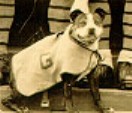Basketball Home > Football Home > Traditions > The Bulldog

Georgetown Traditions: Jack The Bulldog
Georgetown's nickname is a Hoya, but its mascot is a bulldog. This bulldog is known as Jack, but many other dogs through the years have been a part of Georgetown teams.

Among the earliest mascots was a terrier named Stubby, whose name is largely unfamiliar today but was perhaps the most famous dog of his generation. According to the Associated Press, the legend of Stubby started in at the Yale Bowl in 1916, when the mongrel wandered onto the field as the Connecticut National Guard was training for war. When the 102nd Infantry Regiment went overseas to fight in World War I, Stubby was smuggled along.
Stubby was more than a mascot. The dog served 18 months on the front with his regiment in World War I, saving his regiment from surprise mustard gas attacks, locating wounded soldiers, and even catching a German spy by the seat of his pants. Such exploits made the front page of newspapers back home, and after Stubby's last battle at Chateau-Thierry, France, he was outfitted with a blanket with the medals and honors awarded him for bravery, with flags of all the Allied Nations of the war.
Returning home, Stubby was invited to the White House by President Wilson and was personally decorated for valor by General John J. Pershing in a post-war ceremony. It was the bravery and loyalty of this dog that was instrumental in inspiring the creation of the U.S. "K9 Corps" for World War II.
In 1921, Stubby's owner, J. Robert Conroy, was headed to Georgetown for law school and took the dog along. According to a 1983 account in Georgetown Magazine, Stubby "served several terms as mascot to the football team. Between the halves, Stubby would nudge a football around the field [with his nose], much to the delight of the crowd. This trick became a standard feature of the repertoire of Georgetown mascots throughout the twenties and thirties. "
Stubby died in 1926. His mounted remains and medal-encrusted blanket were displayed for years at the National Red Cross Museum and were presented in 1956 to the Smithsonian. After forty years in moth balls (literally), Stubby is now on loan to the State of Connecticut, which featured the war hero at a statewide dog show.
Following Stubby, a terrier named, appropriately, "Hoya", became a fan favorite. Hoya belonged to Rev. Vincent McDonough, S.J., Moderator of Athletics and namesake of McDonough Gymnasium. This terrier was frequently seen at Georgetown football games in the 1920's and 1930's. A Great Dane named "Butch" became the team's unofficial mascot during the 1940's, but as Georgetown suspended football in 1951, the tradition of live mascots ended. Years later, the name of "Jack" and the breed of English Bulldog was formally adopted in 1962, adding the blue and gray cap once worn by freshmen onto its emblem.
Students maintained pet bulldogs as mascots into the early 1970's. By 1979, Georgetown was one of the first schools to employ a "human mascot", a student in the now familiar blue and gray bulldog suit. "Jack" now appears at major athletic and social events, and is among the most recognizable college mascots in the nation. (Jack is not to be confused with "Joe Hoya", which is a traditional campus expression for the everyday Georgetown student.)
A genuine bulldog pup returned to campus in the summer of 1999 and the new "Jack" became a regular on campus. When Rev. Scott Pilarz, S.J. was named president of the University of Scranton in the spring of 2003, Jack opted to retire to Pennsylvania with his owner. By summer, a new bulldog pup arrived to carry on the duties of Georgetown's top dog. Like any new Hoya, he is still learning the way around campus, but should become a Georgetown tradition all his own very soon.
HoyaSaxa.com:
The One-Stop Web Site For Hoya Basketball™
An independent web site not affiliated with Georgetown University. All rights reserved.